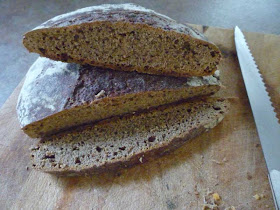A Boiled Whole Grains Bread
The ideas for this bread really developed due to other recipes I've made: James Beard's Cracked Wheat bread, and more recently the granola (bars) I made (by mistake) without any eggs. The first one told me that you really don't need to let your boiled grains cool down completely before using them; the gums in the boiled grains are sticky enough to help give some cohesion to the loaf. The second one gave me the idea that you could add some dough to some (boiled) grains and you might get some cohesion without requiring it to have an egg.
But truth be told, Reinhart has some boiled grain breads too. I have already baked his Multigrain Sandwich Loaf, which can use boiled grains. And the Sandwich Struan can be made this way. But this was going to be a quick and dirty recipe, pure play. The dough was actually from a Sourdough English Muffin recipe. This is a sweet dough, it already contains molasses. I would just add some boiled grains to it.
This was the whole dough; I would only use half of it with these grains.
I gathered a few grains together that I thought I'd like to try boiled. I used 1/4 cup each of:
- flax
- millet
- roasted buckwheat
- cracked wheat
- whole rye berries
- red quinola
I boiled this over 10 minutes in 2 cups of water, until all was absorbed. The scent of the buckwheat was a bit overpowering. I think this was because it was roasted already, but I don't know. What I really wanted to use was barley, I think. I think I have some pearled barley, but the bag wasn't properly labeled. Damn.
Boiling the Grains
The pot requires an extensive clearnup from the boiled grains sticking to it. Maybe a little oil in the pot might help this? Or more attentive stirring?
The Dough falls apart with the hot grains added and kneaded in.
I removed it 5 minutes from the heat before I tried to mix it into the dough. The dough had already risen once, and had been divided, and rested another 15 minutes. So the gluten was already well developed in the dough. But when I added these grains, the gluten fell apart and I had a mess. I think the grains were still very hot, and when they hit the dough, the dough just broke its gluten.
The Dough doesn't even fill the tin from one end to the other
That's when I decided I'd just chalk this up to another failure. I would just dump it into a loaf pan, though, and see what happened when I baked it. The dough was not well developed gluten anymore. It was just glop, and continued kneading wasn't helping. I sort of poured it, scraped it, into a loaf tin. And I didn't expect it would rise any more. Shoot, it didn't even fill to one end of the pan.
I let it sit about 30 minutes and I noticed that there was some activity underneath the towel. It was rising after all. I preheated the oven to 425. But by the time the oven was preheated, the tin was now overflowing.
Overflow
I put it into the oven. But this dough was jiggly. There wouldn't be any gluten cloak. I thought it would continue to overflow the loaf tin, so I placed it on a baking sheet to catch the drips. I used steam for the crust, but it could have been improved by brushing on a glaze.
No oven spring: oven droop
I baked it at 400 degrees F. for 20 minutes, then turned the loaf for another 20 minutes.
I dreaded scraping this loaf from the well-oiled, no-stick pan. I let it sit in the pan for 30 minutes before taking a knife to the edges to try to get it out of there. It actually came out intact, and quite easily. Too easily. I touched a finger to the bottom of the loaf. Still felt like jelly. Gooey. I put it back into the oven, upside down on the baking tray, for another 12 minutes at 350 degrees (though most of that time was preheating). That helped form some crust along the bottom half of the loaf, but I was still worried about the interior.
The globs that had overflowed onto the pan tasted like the marriage of blah unsweetened crunchy overcooked granola bars and burnt toast. Was this the taste I was going for?
Notes to Myself
- Try this again using a real dough. Use delayed fermentation in the fridge to develop flavour, use some whole what and some rye flours. Try using only 10% all purpose. Try it without any.
- Perhaps more enrichment: why not some honey? Hey, why not an egg?
- Try glazing the finished loaf. Hey, why not use an egg?
- Put some oil into your boiling water so the gluey grains don't stick as much.
- Try waiting 10 or 15 minutes before adding the boiled grains. They don't have to be room temperature, but at least they shouldn't destroy the gluten structure that is already there, should they?

























































